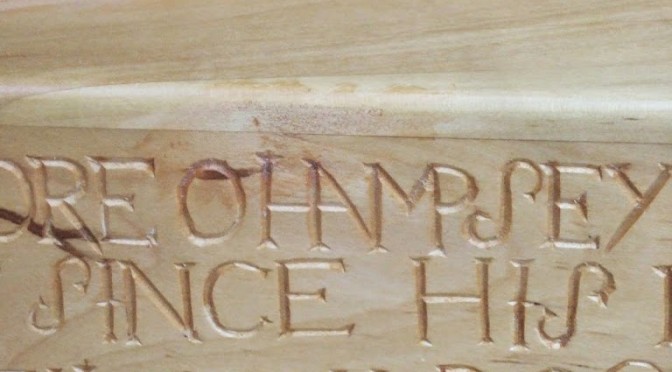Two years ago to the week, I had my HHSI Student Downhill harp here in preparation for using it for a concert – my Carolan, Connellan and Lyons programme which I played outside in the Botanic Garden. While the harp was here I carved the lettering on the forepillar, and gilded the carved letters.
This week the harp is again at my house, as I am going to use it for my Lament for the Union concert next week. And so how could I resist continuing my very protracted programme of decorating the instrument?
 As well as some subtle painted highlights, today I carved the lettering for the poem on the soundbox. I traced my photograph of Cormick O’Kelly’s original 18th century poem, but I changed the lettering to be relevant to me and to this particular instrument. I like the idea of changing the poem – like how a modern harpsichord maker puts a replica Ruckers or Blanchard rose in the soundboard of their replica harpsichord, but replaces the old master’s initials with their own.
As well as some subtle painted highlights, today I carved the lettering for the poem on the soundbox. I traced my photograph of Cormick O’Kelly’s original 18th century poem, but I changed the lettering to be relevant to me and to this particular instrument. I like the idea of changing the poem – like how a modern harpsichord maker puts a replica Ruckers or Blanchard rose in the soundboard of their replica harpsichord, but replaces the old master’s initials with their own.
I was originally planning to gild this lettering but now that it is finished, because the letters are significantly smaller than the gilded forepillar ones, and because there are so many more of them, I decided I liked them natural wood. The poem is quite hard to read with all the ligatures and the crowded capital letters with few word spaces. I think it gives a subtle lift to the whole instrument.
I love it when ancient things have inscriptions on them, it is a kind of literature, and it is also a kind of direct communiaction between the thing and ourselves, more direct than we usually get with archaeological objects where the comminication has to be inferred or reconstructed. I am very pleased to have captured a little of that atmosphere and ambience on my harp now, even though it is not actually an ancient harp or even an ancient text – nonetheless it is like the harp is speaking directly to us.
I was also struck by the final 2 words of the poem: “call me”, like the monster in The Forest.

















